Visual Art
‘A Call to the Ancestors’ ponders, honors those who came before us
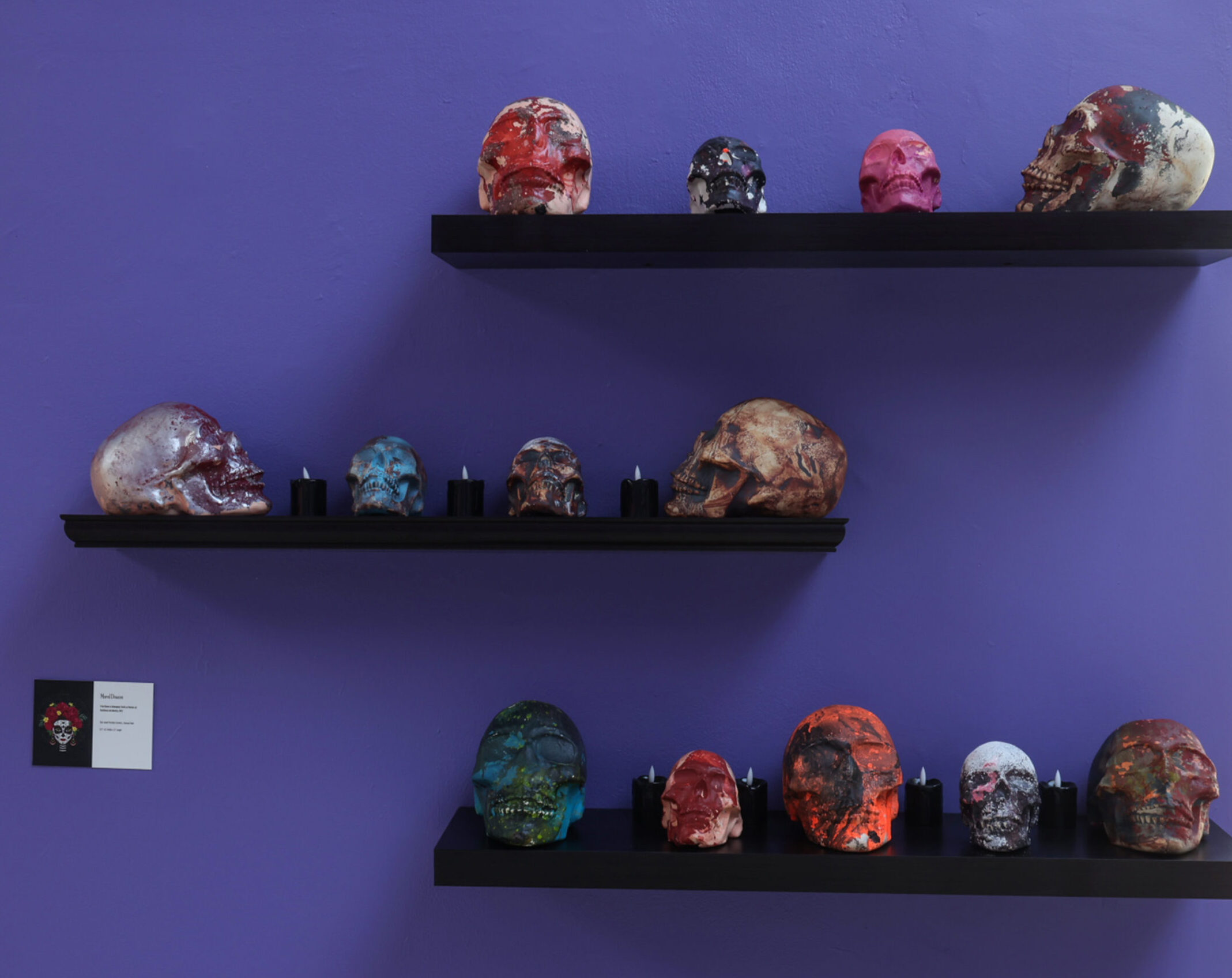
Morel Ducet’s “Bones of Belonging: Skulls as Markers of Resilience and Identity,” pays homage to a diversity of cultures in “A Call to Ancestors” at the Little Haiti Cultural Complex. The multi-media exhibition has been extended through Sunday, March 10. (Photo courtesy of Carl-Philippe Juste)
It all started when Carl-Philippe Juste, the storied Miami Herald photojournalist, was asked to help create an exhibit about the nearly forgotten Lincoln Memorial Park cemetery, the resting place of many early African-American Miamians.
The 2018 Coral Gables Museum show, “Caretakers,” celebrated those who stepped up, often without pay, to help maintain the Brownsville site, with its unusual above-ground mausoleums and crowded tombstones that are a witness to Miami’s African American past. The park is, in many ways, a document of the experience of Miami’s people of color. There’s hatred and racism – lynching victims are buried there. But there is also a testament to resilience, achievement and pride – U.S Armed Forces veterans rest there, as do Bahamian immigrants who helped build and settle early Miami.
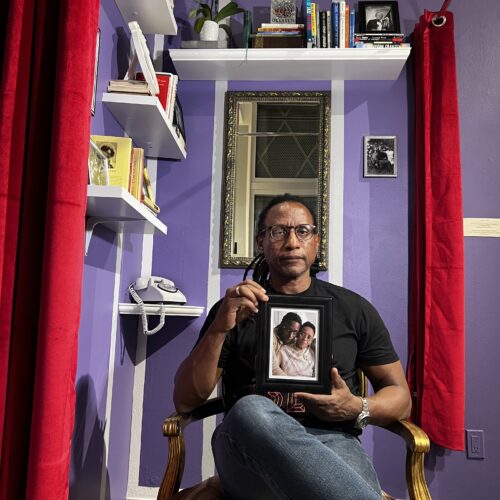
Show curator Carl-Philippe Juste sits in the installation “The Parlor.” (Photo courtesy of C.W Griffin)
“I felt that the subject matter had many different things that flowed throughout the community,” said Juste, who asked himself “if the dead speak: And the answer is ‘yes.’ ”
Since then, he’d been planning the current exhibit, turning over in his mind how it should come into being. “I had the vision, then deconstructed it to build it in parts,” says Juste. “If you are willing to listen, you can hear the dead speak, so the idea is: what are they saying to us, and how can I tap into that?”
Those ideas form the genesis of “A Call to the Ancestors,” at the Little Haiti Cultural Complex, curated by Juste. It’s an alchemy of visual art, installation, documentary, poetry, essays and narrative that inquire what those who came before us still have to say. And, it invites those connections to inform our lives, while enlarging the Lincoln Memorial Park story.
The show, which runs through March, is a collaboration of The Haitian Cultural Arts Alliance of which Juste is the executive director of its board, and Florida International University entities, including the Wolfsonian Public Humanities Lab, and the Mellon Foundation-funded project: Commons for Justice: Race, Risk, Resilience. FIU history professor Rebecca Friedman, who founded the humanities lab, and is co-director of the Mellon Foundation grant, encountered Juste at the Coral Gables Museum show and knew his project was a perfect fit for the foundation.
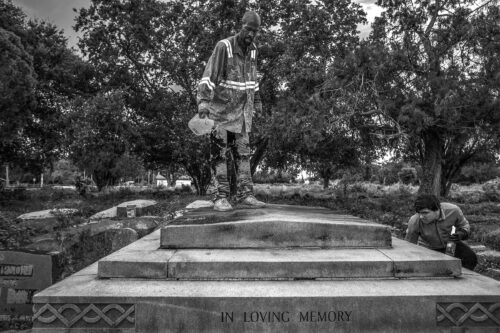
In “Cleansing,” Lincoln Memorial Park cemetery caretaker Arthur Kennedy helps keep the site clean. (Photo courtesy of Carl-Philippe Juste)
“You have images of the caretakers, those who are searching for buried history, and then the other part of the exhibition is really about the ways the ancestors continue to speak,” says Friedman.
Along with a documentary about and photos of the cemetery, the show celebrates “the rituals of transition,” from Haitian, Central and South American, Caribbean and Native American communities that complement the focus on the African American experience in Miami.
The exhibit’s first section includes essays by columnist Leonard Pitts Jr., and Miami Herald reporter C. Isaiah Smalls II, with their calls to remember and celebrate Black history and experience, plus poetry by award-winning Haitian American writer Edwidge Danticat, along with artwork, much of it created specifically for the show.
Especially arresting are the brightly colored ceramic skulls by noted Haitian-born ceramic artist Morel Doucet. Titled “Bones to Belonging: Skulls as Markers of Resilience and Identity,” it references not only Latin America and Mexican traditions, but seem to evoke a celebratory intimacy with those who have passed.
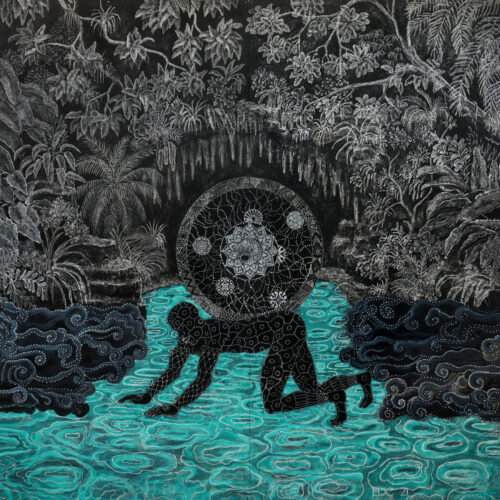
“Beast of Burden,” by Edouard Duval Carrié, is both magical and horrifying. (Photo courtesy of Carl-Philippe Juste)
Doucet noted In an interview with Colossal, the online arts and culture site, that the subject matter and imagery are not what he typically explores, but in this commissioned piece, he said, “I wanted to find a way to pay homage to various cultures. Blackness is not a monolith–you have Haitians, Bahamians, Jamaicans, Black Americans–and so I wanted to find ways to represent that diversity, which is why all the skulls are slightly different.”
In “Vidrio: The Face in the Glass,” novelist Ana Menéndez painted a portrait of her grandmother, her face surrounded with buttons, an homage to her mastery with needle, thread and fabric, intertwined with stories and narrative.
Yet Juste’s interactive installation, “The Parlor” is possibly the most moving. A chair in what looks like a home’s alcove is flanked by a bookshelf and a mirror. Photos of Juste’s family nestle beside the books. There is a house plant. A rotary phone sits nearby. Visitors, who see themselves in a gilded mirror, can pick up the phone and leave a message for their own departed family members.
“You need space to connect with people,” says Juste, noting that the installation is an homage to his parents. “Whenever I have a problem I call upon them – and if it works for me I figure it might work for others. So I give then a vehicle to at least start the conversation.” “The Parlor,” he says, is a vessel to have difficult – or lovely – conversations, “I am not one who believes in goodbyes.” The entire exhibit, he notes, “Is a conversation happening on both ends.”
(Go Inside “A Call to The Ancestors” Catalogue)
Juste’s parents are known and celebrated in Miami, and are considered the moving spirits in establishing Little Haiti. In 2022, NE 59th Street from North Miami Avenue to NE Fourth Court, was named for Viter and Maria Juste.
Moving toward the exhibit’s second room, one encounters large format photos of the cemetery, many by Juste. Those include poignant images of caretakers, including Arthur Kennedy, looking like an angel of protection, and a tattered American flag overseeing an armada of above-ground tombs.
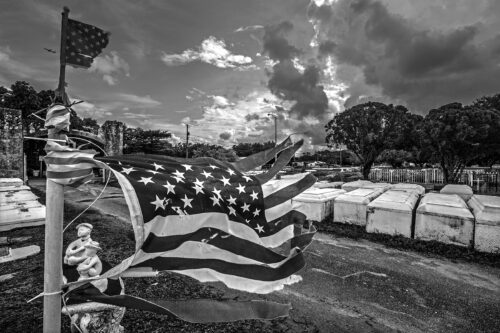
In “Frayed Glory,” a weathered American flag still waves above the graves at Lincoln Memorial Park cemetery. Photo courtesy of Carl-Philippe Juste)
At the far wall is a piece by celebrated Haitian-born artist Edouard Duval Carrié titled “Beast of Burden,” an absorbing, magical work that speaks to the unpaid labor of those kidnapped from Africa and brought to the Americas.
The show, which opened in September, was originally slated to close in November but has been extended through March. It is now also expected to travel to other venues, which may include historically Black colleges and universities.
WHAT: “A Call to the Ancestors”
WHEN: 10 a.m. to 9 p.m., Monday through Friday; Saturday and Sunday times may vary based on programming and events, through Sunday, March 10. 10:30 a.m. to 12:30 p.m., Friday, Dec. 8, Art Week studio open house with Edouard Duval-Carrié’s studio, IPC ArtSpace, and other venues at the complex open for visitors.
WHERE: Little Haiti Cultural Center 212-260 NE 59th Terrace, Miami
COST: Free
INFORMATION: (305) 960-2969 or miami.gov/LHCC
ArtburstMiami.com is a nonprofit media source for the arts featuring fresh and original stories by writers dedicated to theater, dance, visual arts, film, music and more. Don’t miss a story at www.artburstmiami.com
